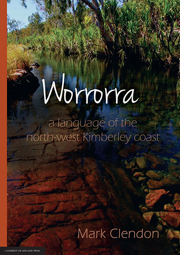Book contents
- Frontmatter
- Dedication
- Contents
- List of tables
- List of figures
- Abbreviations
- Acknowledgements
- Chapter One introduction
- Chapter Two segmental phonology
- Chapter Three morphophonology
- Chapter Four nouns and noun classes
- Chapter Five indicative mood and basic verbal morphology
- Chapter Six adjectives and inalienable nouns
- Chapter Seven pronouns, demonstratives, anaphors, deictics
- Chapter Eight optative, counterfactual and exercitive moods
- Chapter Nine number
- Chapter Ten adverbs and postpositional phrases
- Chapter Eleven complex predicates
- Chapter Twelve experiencer constructions
- Chapter Thirteen objects and possession
- Chapter Fourteen complement clauses
- Chapter Fifteen subjunctive verbs
- Chapter Sixteen middle voice
- Chapter Seventeen discourse cohesion
- Chapter Eighteen kinship terms
- Appendices
- References
Chapter Eighteen - kinship terms
Published online by Cambridge University Press: 05 October 2014
- Frontmatter
- Dedication
- Contents
- List of tables
- List of figures
- Abbreviations
- Acknowledgements
- Chapter One introduction
- Chapter Two segmental phonology
- Chapter Three morphophonology
- Chapter Four nouns and noun classes
- Chapter Five indicative mood and basic verbal morphology
- Chapter Six adjectives and inalienable nouns
- Chapter Seven pronouns, demonstratives, anaphors, deictics
- Chapter Eight optative, counterfactual and exercitive moods
- Chapter Nine number
- Chapter Ten adverbs and postpositional phrases
- Chapter Eleven complex predicates
- Chapter Twelve experiencer constructions
- Chapter Thirteen objects and possession
- Chapter Fourteen complement clauses
- Chapter Fifteen subjunctive verbs
- Chapter Sixteen middle voice
- Chapter Seventeen discourse cohesion
- Chapter Eighteen kinship terms
- Appendices
- References
Summary
Worrorra kinship nouns are nominal expressions which include reference to the propositus (the ‘owner,’ a structurally dependant NP) as well as to the structural head, the person designated as being in such-and-such a relation to the propositus. Although the grammar of Worrorra kinship nominals has been discussed in §13.1, it is relevant here to provide an inventory of Worrorra kinship terms with their equivalents in the usual anthropological metalanguage. As well as being of interest in its own right, such an inventory can be useful in comparative exercises such as that undertaken by McConvell (1997).
Elkin (1954:49-79, see also Berndt & Berndt 1964:76) identifies the north Kimberley or Ungarinyin kinship system as one of five major types of kinship system found in Australia. It is based on the extended patrilineal family or clan as the basic-level category for the purpose of reckoning relatedness. In this system all members of an extended family are to a certain extent equivalent for kinship-reckoning purposes, and terminology reflects this situation. It is what Elkin calls a ‘vertical’ system, in the sense that entire extended families or clans are egocentrically labelled, with either all generations referred to by a single term, or with different terms used for alternating generations. This situation is evident in Lucich's (1968) exposition, and made explicit in Silverstein (nd 1).
- Type
- Chapter
- Information
- WorrorraALanguage of the North-West Kimberley Coast, pp. 460 - 466Publisher: The University of Adelaide PressPrint publication year: 2014



